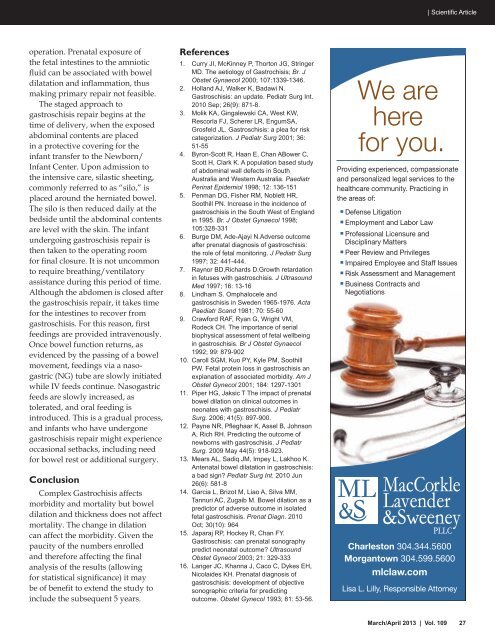March/April - West Virginia State Medical Association
March/April - West Virginia State Medical Association
March/April - West Virginia State Medical Association
You also want an ePaper? Increase the reach of your titles
YUMPU automatically turns print PDFs into web optimized ePapers that Google loves.
| Scientific Article<br />
operation. Prenatal exposure of<br />
the fetal intestines to the amniotic<br />
fluid can be associated with bowel<br />
dilatation and inflammation, thus<br />
making primary repair not feasible.<br />
The staged approach to<br />
gastroschisis repair begins at the<br />
time of delivery, when the exposed<br />
abdominal contents are placed<br />
in a protective covering for the<br />
infant transfer to the Newborn/<br />
Infant Center. Upon admission to<br />
the intensive care, silastic sheeting,<br />
commonly referred to as “silo,” is<br />
placed around the herniated bowel.<br />
The silo is then reduced daily at the<br />
bedside until the abdominal contents<br />
are level with the skin. The infant<br />
undergoing gastroschisis repair is<br />
then taken to the operating room<br />
for final closure. It is not uncommon<br />
to require breathing/ventilatory<br />
assistance during this period of time.<br />
Although the abdomen is closed after<br />
the gastroschisis repair, it takes time<br />
for the intestines to recover from<br />
gastroschisis. For this reason, first<br />
feedings are provided intravenously.<br />
Once bowel function returns, as<br />
evidenced by the passing of a bowel<br />
movement, feedings via a nasogastric<br />
(NG) tube are slowly initiated<br />
while IV feeds continue. Nasogastric<br />
feeds are slowly increased, as<br />
tolerated, and oral feeding is<br />
introduced. This is a gradual process,<br />
and infants who have undergone<br />
gastroschisis repair might experience<br />
occasional setbacks, including need<br />
for bowel rest or additional surgery.<br />
Conclusion<br />
Complex Gastrochisis affects<br />
morbidity and mortality but bowel<br />
dilation and thickness does not affect<br />
mortality. The change in dilation<br />
can affect the morbidity. Given the<br />
paucity of the numbers enrolled<br />
and therefore affecting the final<br />
analysis of the results (allowing<br />
for statistical significance) it may<br />
be of benefit to extend the study to<br />
include the subsequent 5 years.<br />
References<br />
1. Curry JI, McKinney P, Thorton JG, Stringer<br />
MD. The aetiology of Gastrochisis; Br. J<br />
Obstet Gynaecol 2000; 107:1339-1346.<br />
2. Holland AJ, Walker K, Badawi N.<br />
Gastroschisis: an update. Pediatr Surg Int.<br />
2010 Sep; 26(9): 871-8.<br />
3. Molik KA, Gingalewski CA, <strong>West</strong> KW,<br />
Rescorla FJ, Scherer LR, EngumSA,<br />
Grosfeld JL. Gastroschisis: a plea for risk<br />
categorization. J Pediatr Surg 2001; 36:<br />
51-55<br />
4. Byron-Scott R, Haan E, Chan ABower C,<br />
Scott H, Clark K. A population based study<br />
of abdominal wall defects in South<br />
Australia and <strong>West</strong>ern Australia. Paediatr<br />
Perinat Epidemiol 1998; 12: 136-151<br />
5. Penman DG, Fisher RM, Noblett HR,<br />
Soothill PN. Increase in the incidence of<br />
gastroschisis in the South <strong>West</strong> of England<br />
in 1995. Br. J Obstet Gynaecol 1998;<br />
105:328-331<br />
6. Burge DM, Ade-Ajayi N.Adverse outcome<br />
after prenatal diagnosis of gastroschisis:<br />
the role of fetal monitoring. J Pediatr Surg<br />
1997; 32: 441-444.<br />
7. Raynor BD,Richards D.Growth retardation<br />
in fetuses with gastroschisis. J Ultrasound<br />
Med 1997; 16: 13-16<br />
8. Lindham S. Omphalocele and<br />
gastroschisis in Sweden 1965-1976. Acta<br />
Paediatr Scand 1981; 70: 55-60<br />
9. Crawford RAF, Ryan G, Wright VM,<br />
Rodeck CH. The importance of serial<br />
biophysical assessment of fetal wellbeing<br />
in gastroschisis. Br J Obstet Gynaecol<br />
1992; 99: 879-902<br />
10. Caroll SGM, Kuo PY, Kyle PM, Soothill<br />
PW. Fetal protein loss in gastroschisis an<br />
explanation of associated morbidity. Am J<br />
Obstet Gynecol 2001; 184: 1297-1301<br />
11. Piper HG, Jaksic T The impact of prenatal<br />
bowel dilation on clinical outcomes in<br />
neonates with gastroschisis. J Pediatr<br />
Surg. 2006; 41(5): 897-900.<br />
12. Payne NR, Pfleghaar K, Assel B, Johnson<br />
A, Rich RH. Predicting the outcome of<br />
newborns with gastroschisis. J Pediatr<br />
Surg. 2009 May 44(5): 918-923.<br />
13. Mears AL, Sadiq JM, Impey L, Lakhoo K.<br />
Antenatal bowel dilatation in gastroschisis:<br />
a bad sign? Pediatr Surg Int. 2010 Jun<br />
26(6): 581-8<br />
14. Garcia L, Brizot M, Liao A, Silva MM,<br />
Tannuri AC, Zugaib M. Bowel dilation as a<br />
predictor of adverse outcome in isolated<br />
fetal gastroschisis. Prenat Diagn. 2010<br />
Oct; 30(10): 964<br />
15. Japaraj RP, Hockey R, Chan FY.<br />
Gastroschisis: can prenatal sonography<br />
predict neonatal outcome? Ultrasound<br />
Obstet Gynecol 2003; 21: 329-333<br />
16. Langer JC, Khanna J, Caco C, Dykes EH,<br />
Nicolaides KH. Prenatal diagnosis of<br />
gastroschisis: development of objective<br />
sonographic criteria for predicting<br />
outcome. Obstet Gynecol 1993; 81: 53-56.<br />
We are<br />
here<br />
for you.<br />
Providing experienced, compassionate<br />
and personalized legal services to the<br />
healthcare community. Practicing in<br />
the areas of:<br />
Defense Litigation<br />
Employment and Labor Law<br />
Professional Licensure and<br />
Disciplinary Matters<br />
Peer Review and Privileges<br />
Impaired Employee and Staff Issues<br />
Risk Assessment and Management<br />
Business Contracts and<br />
Negotiations<br />
S L Charleston 304.344.5600<br />
Morgantown 304.599.5600<br />
mlclaw.com<br />
Lisa L. Lilly, Responsible Attorney<br />
<strong>March</strong>/<strong>April</strong> 2013 | Vol. 109 27















